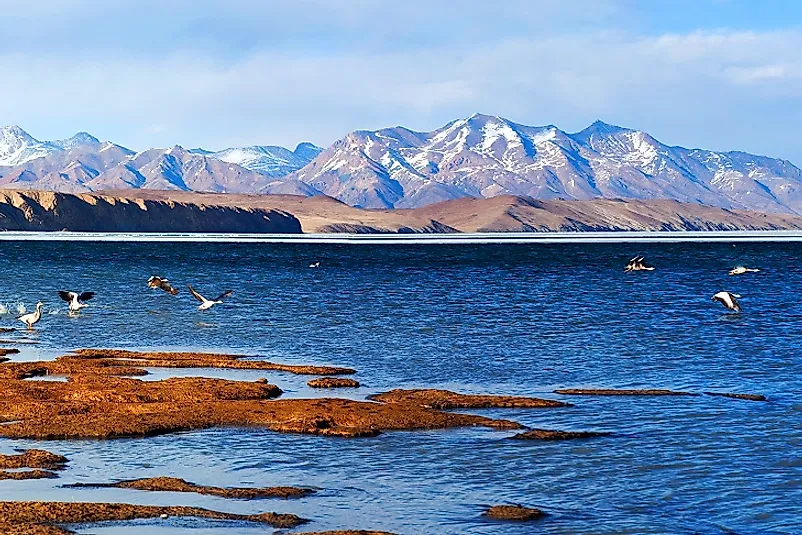Where is Lake Manasarovar?

5. Description
Highly regarded as a sacred lake by followers of four religions, Hindus, Buddhists, Jains and Bons, the Manasarovar Lake is a vast freshwater lake located 15,060 feet above sea level in the Tibet Autonomous Region, 940 kilometers from Lhasa, the capital city of the region. The lake covers an area of 320 square kilometers, is largely rounded in shape, and has a maximum depth of 300 feet. Lake Manasarovar is linked via the Ganga Chhu channel to the nearby saltwater Lake Rakshastal. The lake is located at the foot of Mount Kailash, a mountain associated with significant religious importance. A number of monasteries exist along the shores of this lake which hosts thousands of pilgrims who visit this lake each year for religious salvation.
4. Unique Hydrology
The unique feature about Lake Manasarovar is the nature of its water in relation to altitude. While it is surrounded by lakes that are mostly salty in nature including the nearby Rakshastal, Manasarovar holds freshwater, allowing it to feature among some of the highest freshwater lakes in the world. The waters of the lake are also famous for their crystal blue color and high levels of purity. The waters freeze each December and start thawing back out once again in May of each year.
3. Religious Significance
Lake Manasarovar is held highly sacred by the Hindus who claim that bathing in the waters of this lake cleanses one of all sins committed over a hundred lifetimes. Hindus also believe that drinking the waters of the lake reserves one’s right to reach heaven after death. The lake is also considered to be the source of the four great Indian rivers of Sindhu, Bhramaputra, Sutlej, and Ghaghara. The nearby Mount Kailash is regarded to be the abode of the powerful Hindu God, Lord Shiva and it is believed that only virtuous individuals can climb the mountain to the top. Like Hindus, the Buddhists also consider the lake to be sacred, a place where Lord Buddha was conceived by his mother. Several Buddhist religious texts and scriptures mention this lake in their accounts. Jains associate the lake with their first tirthankara, Rishabha, while Bons link the lake to their deity, Zhang Zhung Meri.
2. Habitat and Biodiversity
The Lake Manasarovar and its surrounding habitat is extremely rugged, cold and dry. During winters, it becomes dangerous for pilgrims and tourists to visit this place. However, summers are pleasant here with temperatures soaring to as high as 15 to 20 degrees Celsius, and is the best time to visit this destination. Still, high altitude sickness is common among the visitors and pilgrimage teams always include medical professionals as part of their group. Very little data regarding the biodiversity of Lake Manasarovar exists to this date. However, as per tourist accounts, the lake thrives with several varieties of fish. Since the lake is associated with so many religions that practice non-violence and preach love for all living creatures, fishing in Lake Manasarovar is strictly prohibited and so is harming any other form of wildlife in the area.
1. Environmental Threats and Territorial Disputes
Pilgrimage to Lake Manasarovar requires high levels of physical fitness and long hours of walking across dangerous and difficult terrains. This leads to a comparatively a lower footfall of pilgrims and tourists here as compared to pilgrimage destinations of similar significance in the neighboring countries. This helps preserve the sanctity of the lake and its clean environment. However, future plans of development, connecting the lake with other areas via well-developed routes could greatly increase the arrival of large numbers of people here, leading to a decline of the natural quality of the place, polluting its pristine environment.











